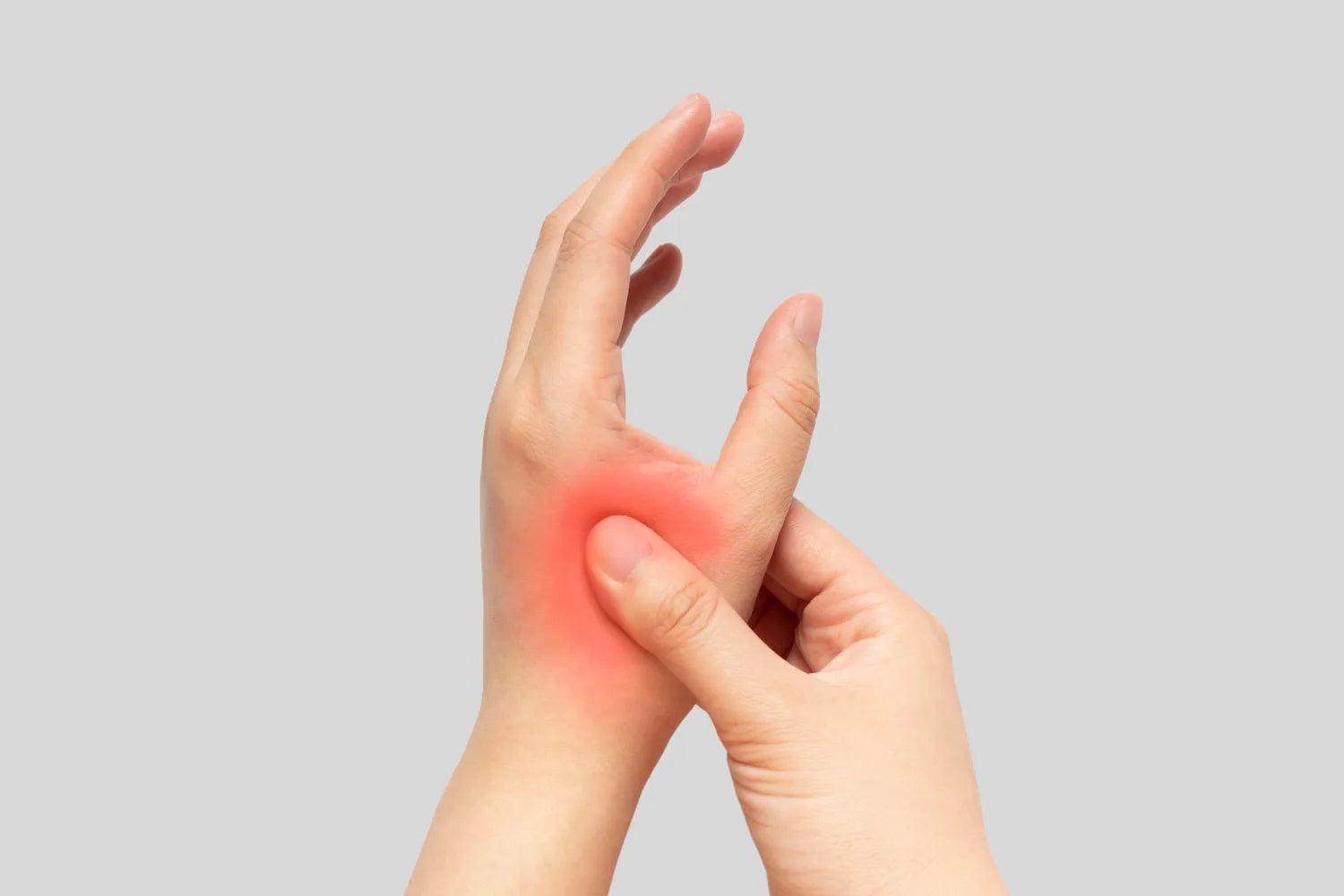8 Causes of Thumb Pain & Relief Options
Thumb pain — it's a discomfort that can turn even the simplest tasks into a challenge. Whether it's a twinge when you're opening a jar or a constant ache throughout the day, it's not something you should ignore. Your thumb plays an important role in many of your daily activities, and discomfort can be a sign that something isn't quite right.
Understanding the causes of thumb pain is the first step toward finding a solution. By getting to the root of the problem, you can start exploring relief options to help you get back to your daily life without discomfort.
Let’s learn more about the thumb joint, its role in your daily activities, and the common causes of thumb pain.
What Is the Anatomy of the Thumb Joint?
Your thumb might seem simple, but it's made up of several key components that all work together to allow for a wide range of motion.
You'll find the carpometacarpal (CMC) joint at the base of your thumb. This joint is a bit of a standout. It's a saddle joint, which means it allows for movement in two planes. This gives your thumb the ability to move away from your palm, a motion known as abduction, and to move across your palm, a motion known as adduction.
The metacarpal is the long bone in your thumb that connects the CMC joint to the trapezium, a small bone in the wrist. This connection is essential for the thumb's ability to oppose or meet the other fingers, a key feature that sets us apart from many other species.
Your thumb joint plays a huge role in many daily activities. From opening jars to turning a doorknob, these actions all rely on the complex structure of the thumb. So, when you're experiencing thumb pain, it can really throw a wrench into your daily routine.
What Are the Common Causes of Thumb Pain?
Thumb pain can be a nuisance, affecting everything from your ability to grip objects to your overall hand function. Let's explore some of the most common causes of this discomfort.
Overuse
Overuse is a frequent cause of thumb discomfort, stemming from excessive strain on the joint during routine activity. Excessive texting, prolonged gripping, or other repetitive movements can result in this undue stress. This continuous burden can lead to irritation in the thumb joint and the surrounding area, resulting in discomfort.
Sprains and Ligament Issues
Thumb sprains and ligament issues are common in athletes and those who participate in activities that put stress on the hand. These injuries can result from a sudden blow or force to the thumb, causing it to bend unnaturally.
Carpal Tunnel Syndrome
Carpal tunnel syndrome can cause thumb pain and other symptoms such as tingling and numbness. It occurs when a nerve that runs from your forearm to your hand becomes compressed at the wrist and is typically associated with overuse or repetitive hand movements.
Bone Spurs
Bone spurs, or osteophytes, are bony projections that develop along the edges of bones. They often form where bones meet each other, like in your thumb joint. While they're usually smooth, they can cause pain if they rub against nerves or restrict movement. This can occur following an injury to the joint or damage to the joint related to underlying medical conditions.
Osteoarthritis (Including Basal Joint Arthritis)
Osteoarthritis is a common cause of thumb discomfort. It occurs when the cartilage that cushions the ends of your bones wears down over time. Osteoarthritis often affects the base of the thumb, a condition known as basal joint arthritis.
Rheumatoid Arthritis
Rheumatoid arthritis is another type of arthritis that can lead to thumb pain. It's an autoimmune disease, meaning your immune system mistakenly attacks your own body's tissues. In this case, it targets the lining of your joints.
De Quervain’s Tenosynovitis
De Quervain’s tenosynovitis is a condition that causes pain on the thumb side of the wrist. It occurs when the tendons around the base of the thumb become irritated or constricted.
Trigger Thumb
Trigger thumb is a condition where your thumb gets stuck in a bent position and then snaps straight. It can be painful, especially when the thumb is bent or straightened.
By understanding these causes, you can take steps to manage your risk and seek appropriate treatment if you're experiencing discomfort.
How Is Thumb Discomfort Diagnosed?
When it comes to persistent thumb pain, a healthcare professional can help you figure out the underlying cause.
An orthopedic or orthopedic hand surgeon is a specialist who can help diagnose thumb pain. They have the skills and knowledge to examine your thumb thoroughly, considering all the potential causes we've discussed. They'll look at your thumb's range of motion, strength, and any noticeable swelling or deformity. They may also ask about your symptoms and medical history to comprehensively understand your situation.
An X-ray can be a valuable tool in diagnosing thumb pain. It provides a clear picture of the bones in your thumb and can help identify issues like arthritis or bone spurs. An X-ray can also rule out other potential causes of pain, such as fractures.
If you're experiencing symptoms of thumb arthritis, such as stiffness, a decreased range of motion, or a grating sensation when you move your thumb, it's essential to seek medical advice. These symptoms can also be associated with other health conditions, so getting a clear diagnosis is important.
What Are Some Thumb Discomfort Relief Options?
Once you know what's causing your thumb discomfort, you can start exploring relief options. There are plenty of strategies that can help, from lifestyle changes to exercises and more.
1. Avoid Overuse
One of the simplest ways to ease thumb discomfort is to avoid overusing your thumb. Be mindful of how much time you spend scrolling on your phone or engaging in other activities that require consistent thumb use, like typing, drawing, or writing. Pay attention to when your thumb discomfort is most apparent and if it is associated with certain activities.
How you hold things in your hand can also contribute to thumb discomfort. Try to take regular breaks during activities that involve your thumb. During these breaks, rest your thumb and do some gentle stretches. This can help prevent stiffness and discomfort.
2. Hand Exercises
Hand exercises can be another effective way to relieve thumb discomfort. They can help strengthen your thumb and improve its range of motion, which can alleviate discomfort.
Thumb touch exercises and thumb extensions, in particular, can help keep your thumb joints flexible and strengthen the muscles that support them.
3. Splint Use
A thumb splint can be transformative when it comes to ongoing thumb discomfort. A splint helps maintain proper alignment of the thumb joint, providing much-needed rest and support. A splint can help reduce strain and alleviate discomfort by keeping the thumb in a neutral position. Make sure the splint fits correctly and is comfortable to wear. You can consult a healthcare professional to find the right one.
4. Ice Pack
An ice pack can be a simple but effective way to manage thumb discomfort. Cold therapy can help reduce swelling and numb the area, providing temporary relief. Before applying it to your skin, remember to wrap the ice pack in a cloth to avoid frostbite. Applying the ice pack for 15 minutes at a time is recommended, with at least a 15-minute break in between.
5. Physical Therapy
Physical therapy, guided by a hand therapist or occupational therapist, can be powerful for managing thumb discomfort. These professionals can provide personalized exercises and strategies that target your specific needs. They can help improve your thumb's strength and flexibility, which can ultimately help reduce discomfort and improve function.
6. Over-the-Counter Medications
Over-the-counter anti-inflammatory medications like ibuprofen can help manage discomfort. However, many OTC medicines, like NSAIDs, can be harsh on the stomach, and some individuals may choose to explore more natural methods before opting for over-the-counter medications.
7. Steroid Injections
Steroid and corticosteroid injections can offer temporary relief by helping respond to irritation around the thumb joint. A medical professional can help determine whether steroid injections should be a part of your overall treatment plan.
8. Try CBD
If your healthcare provider has ruled out any serious causes of discomfort, like illness or injury, CBD could be a great, natural option to support joint health.
CBD, a natural compound found in cannabis and hemp plants, can help ease feelings of discomfort throughout the body — including in the thumb joint. CBD works with your body's endocannabinoid system (ECS), a complex system that influences a range of functions and processes, including discomfort responses.
The ECS is made up of endocannabinoids, enzymes, and cannabinoid receptors found throughout the brain and body. CBD can support our body’s own endocannabinoids to interact with these receptors, helping to maintain healthy stress levels, ease feelings of discomfort, and support overall balance throughout the body.
Because cannabinoid receptors exist in and around the thumb joints, applying CBD to the area can help directly support the source of discomfort. Topicals like our CBD Lotion can be applied directly to the thumb or wherever you're experiencing discomfort.
The CBD in our lotion works with the CB receptors at the muscles and joints beneath the skin, offering a natural method to help ease feelings of tension. It’s important to note that CBD should not be a replacement for consulting a healthcare provider.
When Should You See a Doctor About Thumb Discomfort?
Thumb pain and discomfort can usually be addressed at home. However, there are instances where a doctor may recommend surgical intervention. Surgery is typically recommended when other treatment options haven’t worked and the discomfort is significantly impacting your daily activities.
Conditions like severe arthritis or a severely sprained thumb may necessitate surgical intervention. Your doctor will assist you throughout this decision-making process, outlining the potential benefits and risks to empower you to make an informed decision.
The Bottom Line
Thumb discomfort can stem from various causes, including arthritis, sprains, and overuse, to name a few. Understanding these causes is important to find the most effective relief options, from lifestyle changes like avoiding overuse and practicing hand exercises to using thumb splints or engaging in physical therapy. You can also explore natural methods to ease feelings of discomfort, like CBD.
Remember, your thumb plays an important role in many daily activities, so it's essential not to ignore persistent discomfort. If you're experiencing ongoing issues with your thumb joint, seek professional help. Knowledge is power, and understanding what's causing your discomfort is the first step towards finding a solution that works for you.
We invite you to explore our full range of CBD wellness products at Muscle MX. Our products are designed to work with your body's own systems, supporting balance and wellness. Your wellness journey is uniquely yours, and we're here to support you every step of the way.
Sources:
Our thumbs | PMC
5 exercises to improve hand mobility | Harvard Health
Ice Packs vs. Warm Compresses For Pain | Johns Hopkins Medicine
The endocannabinoid system: Essential and mysterious | Harvard Health














































